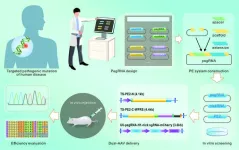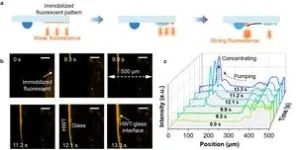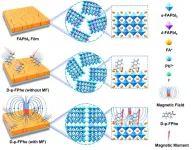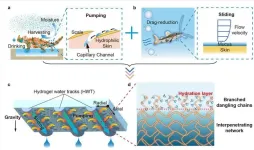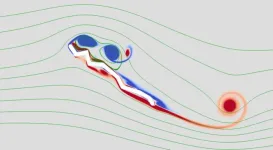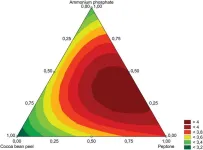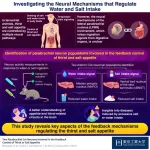(Press-News.org) This study is led by Prof. Xianqun Fan (Department of Ophthalmology, Shanghai Jiao Tong University School of Medicine Affiliated Ninth People’s Hospital).
Gene editing ushers in a new era of disease treatment since many genetic diseases are caused by base-pair mutations in genomic DNA. With the rapid development of genome editing technology, novel editing tools such as base editing and prime editing have attracted public attention, heralding a great leap forward in this field.
Prime editing (PE) was proposed by David Liu’s team in 2019, which is characterized by no need for double-strand breaks (DSBs) or homology sequence templates with variable application scenarios, including point mutations as well as insertions or deletions. The PE system is composed of two parts: prime editors (PEs) and prime editing guide RNA (pegRNA). Prime editors are a kind of fusion proteins between a Streptococcus pyogenes Cas9 (SpCas9) H840A nickase mutant and an engineered reverse transcriptase (RT) domain. The pegRNA functions as both sgRNA and donor template for the desired alteration. It contains a spacer sequence, a scaffold, and a 3’extension that is formed of primer binding sequence (PBS) and RT template (RTT). The spacer sequence will specify the target site. After nicking the PAM-containing DNA strand by the Cas9 nickase domain, the resulting 3’ end will hybridize with the PBS and serve as a DNA primer for reverse transcription by the RT domain.
When delivered into a cell, the PEs are targeted to the editing site and nick the single PAM-containing DNA strand, resulting in a release of the 3ʹ DNA end that can hybridize to the pegRNA extension part. Afterward, the reverse transcriptase performs polymerization of edited DNA from the RT template of pegRNA into the target site, which generates either a 3’ flap with an edit or a 5’ flap without an edit. The preference for 5’ flap excision and 3’ flap ligation finally creates heteroduplex DNA containing one edited strand and one unedited strand. DNA repair or replication copies the edit to the complementary strand and permanently installs the desired edit.
The PE technology has grown and rapidly progressed in the past four years, with versatile advancements in their architecture to increase editing efficiency, targetability, and specificity, including novel pegRNA design, PE modification, and delivery improvement. Additionally, despite relatively recent inception, PE has been extensively applied to correct pathologic mutations from genetic diseases both in vitro and in vivo, which has great potential for moving the field of gene therapy forward from bench to bedside.
In this review, the authors in detail describe the developmental history of prime editing, the newest evolution of CRISPR‒Cas-based technologies. Websites for pegRNA design have been listed, including pegFinder, pegIT, PrimeDesign, and so on. A variety of sequencing methods for off-target prediction are also elaborated upon. Then, the application of PE in human disease models is briefly summarized in the following section, ranging from eye diseases to liver hereditary disorders. With higher editing efficiency and fewer byproducts than traditional editing tools, prime editing holds great promise as a therapeutic strategy for human diseases.
In conclusion, PE is a tremendous milestone in the development of a universal method for genome editing. Its clinical adaptation toward the precise correction of known pathogenic mutations in human diseases may catapult the next frontier of personalized treatments.
END
Prime editing: Current advances and therapeutic opportunities in human diseases
2024-01-26
ELSE PRESS RELEASES FROM THIS DATE:
Highly oriented perovskite films induced by chiral molecules under magnetic-field control
2024-01-26
In the realm of clean energy, metal halide perovskite solar cells (PSCs) have emerged as a groundbreaking focus, capturing significant attention for their extraordinary advancements. In just over a decade, their certified power conversion efficiency (PCE) has skyrocketed to 26.1%, approaching the upper limits seen in traditional crystalline silicon cells. What sets PSCs apart is their potential to surpass the 30% PCE threshold [1].
The key to optimizing solar devices lies in the deposition of high-quality perovskite films. Achieving minimal defect density and exceptional homogeneity becomes crucial for enhancing device performance. One commonly employed strategy involves introducing ...
Bioinspired hydrogel pattern enhancing atmospheric water harvesting via directional droplet steering
2024-01-26
This study, led by Prof. Jiuhui Qu, Dr. Qinghua Ji, and Dr. Wei Zhang from Tsinghua University, focuses on addressing water scarcity by exploring atmospheric water harvesting. The water in the air originates from both natural and forced evaporation, with condensation being the final and crucial step in water harvesting. Condensation involves nucleation, growth, and shedding of water droplets, which are then collected. However, uncontrollable growth of condensed droplets leading to surface flooding is a pressing challenge due to insufficient driving forces, posing a threat to sustainable condensation.
To expedite this process and achieve orderly ...
App enhances nurses' care coordination competency for critically ill patients
2024-01-26
To improve the care coordination competency of nurses involved in the management of critically ill patients on life support, an electronic app—NCCCS—was developed by Associate Professor Chie Takiguchi of Toho University and Professor Tomoko Inoue of International University of Health and Welfare.
The NCCCS app utilizes the scoring system referred to as the Nurses' Care Coordinate Competency Scale (NCCCS), developed by Dr. Takiguchi et al. in 2017, and it is currently being translated into Chinese, Italian, Polish, and Persian. This app offers immediate feedback to nurses caring for critically ill patients on life ...
Dragonfly wings used to study relationship between corrugated wing structure and vortex motions
2024-01-26
Scientists from Hiroshima University undertook a study of dragonfly wings in order to better understand the relationship between a corrugated wing structure and vortex motions. They discovered that corrugated wings exhibit larger lift than flat wings.
Their work was published in the journal Physical Review Fluids on December 7, 2023.
The researchers set out to determine if the corrugation of a dragonfly's wing is a secret ingredient for boosting lift. While past research has largely zoomed in ...
Peach-palm waste and Trichoderma stromaticum: The potential of Cost-effective amylase production
2024-01-26
Amylases are among the most important biotechnological and industrial enzymes that can be applied in various sectors, such as food, pharmaceuticals, textiles, chemicals, paper, and detergents.
The enzymes’ costs come from a range of factors including the quantity produced, the production process, the expense of its recovery, and the degree of purity at which it will be marketed, etc. The use of agro-industrial substrates and microorganisms brings the potential to low-cost enzyme production. Meanwhile, due to the ability to improve physical and chemical resistance to industrial environmental extremes, such as high temperature and pH, as well ...
Decoding how the brain manages the appetite for salt and water
2024-01-26
Staying hydrated and consuming appropriate amounts of salt is essential for the survival of terrestrial animals, including humans. The human brain has several regions constituting neural circuits that regulate thirst and salt appetite, in intriguing ways.
Previous studies suggested that water or salt ingestion quickly suppresses thirst and salt appetite before the digestive system absorbs the ingested substances, indicating the presence of sensing and feedback mechanisms in digestive organs that help real-time thirst and salt appetite modulation in response to drinking ...
Immunocompromised patients and COVID infections: Who’s at risk?
2024-01-26
Early in the pandemic, clinicians noticed that certain immunocompromised patients were experiencing persistent SARS-CoV-2 infections, some lasting weeks to months at a time.
This raised concerns that one of these cases could be the source of an emerging viral variant that has benefited from an extended battle with the immune system.
A prospective study published in the journal Lancet Microbe provides more clarity on which patient populations are at higher risk for prolonged infections —and hints that this fear is likely unwarranted.
The ...
New tool improves the search for genes that cause diseases
2024-01-26
A new statistical tool developed by researchers at the University of Chicago improves the ability to find genetic variants that cause disease. The tool, described in a new paper published January 26, 2024, in Nature Genetics, combines data from genome wide association studies (GWAS) and predictions of genetic expression to limit the number of false positives and more accurately identify causal genes and variants for a disease.
GWAS is a commonly used approach to try to identify genes associated with a range of human traits, including most common diseases. Researchers compare genome sequences ...
Glacier melting destroys important climate data archive
2024-01-26
As part of the Ice Memory initiative, PSI researchers, with colleagues from the University of Fribourg and Ca’ Foscari University of Venice as well as the Institute of Polar Sciences of the Italian National Research Council (CNR), analysed ice cores drilled in 2018 and 2020 from the Corbassière glacier at Grand Combin in the canton of Valais. A comparison of the two sets of ice cores published in Nature Geoscience shows: Global warming has made at least this glacier unusable as a climate archive.
Reliable information about the past climate and air pollution can no longer be obtained from ...
Soap bark discovery offers a sustainability booster for the global vaccine market
2024-01-26
A valuable molecule sourced from the soapbark tree and used as a key ingredient in vaccines, has been replicated in an alternative plant host for the first time, opening unprecedented opportunities for the vaccine industry.
A research collaboration led by the John Innes Centre used the recently published genome sequence of the Chilean soapbark tree (Quillaja saponaria) to track down and map the elusive genes and enzymes in the complicated sequence of steps needed to produce the molecule QS-21.
Using transient expression techniques developed at the John Innes Centre, the team reconstituted the ...
